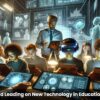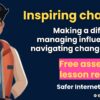
I cannot take credit for these 6 myths of digital technology – I’m lifting them straight from what I thought was a well known and received investigation in to the impact of digital technology on education. It would appear that a lot of the research however is not well known and in an attempt to do for others as I do for my students in terms of making the implicit explicit; this marks the first of a series of posts which will look in to the evidence behind digital technology and its links to learning. In this post I will be looking at an investigation undertaken by Professor Steven Higgins, ZhiMin Xiao and Maria Katsipataki from the School of Education at Durham University, published for the Education Endowment Foundation.
To summarise their findings, as I’ve mentioned before, it’s not about technology, it’s about pedagogy. They also state very clearly that “the use of technology needs to be informed by context and research“. Hear hear.
They state: “it is clear technology alone does not make a difference to learning. Rather, how well the technology is used to support teaching and learning is the key determinant of its impact. There is no doubt that technology engages and motivates young people. However, this benefit is only an advantage for learning if the activity is effectively aligned with clear learning objectives.”
This is absolutely true and why shouldn’t it be? Technology isn’t a panacea for everything, is it? Do you think it is?
Not to take anything away from the summary – it is excellent. Like a York notes of great advice for technology projects. Read it.
So getting back to the title and the excellent postscript of the executive summary on this report; the six myths:
“Myth 1: New technologies are being developed all the time, the past history of the impact of technology is irrelevant to what we have now or will be available tomorrow. After more than fifty years of digital technology use in education this argument is now wearing a bit thin. We need a clear rationale for why we think the introduction of (yet another) new technology will be more effective than the last one. The introduction of technology has consistently been shown to improve learning, the trouble is most things improve learning in schools when they are introduced, and technology is consistently just a little bit less effective than the average intervention.”
“The introduction of technology has consistently been shown to improve learning” – hasn’t it just! However, as they correctly highlight – tech introduction is consistently just that little bit less effective than the average intervention. What can we do therefore to ensure that the intervention and use of technology can improve learning more than other interventions?
“Myth 2: Today’s children are digital natives and the ‘net’ generation – they learn differently from older people. There are two issues with this myth. First, there is no evidence the human brain has evolved in the last 50 years, so our learning capacity remains as it was before digital technologies became so prevalent. It may be that young people have learned to focus their attention differently, but their cognitive capabilities are fundamentally the same as 30 years ago. Second, just because young people have grown up with technology it does not mean they are experts in its use for their own learning. Being an expert at playing Halo 5 requires different skills and knowledge from having an active Facebook account. Most young people are fluent in their use of some technologies, but none are expert at all of them.”
Just like any thing – gaining mastery of it takes time, effort, grit and determination. How else do you think oldies like me are able to do the things we do? Was I born with this ability? No! Time needs to be given to the training of staff, young people and where required, their parents/carers in the systems we put in place to support their learning and progress.
“Myth 3: Learning has changed now we have access to knowledge through the internet, today’s children don’t need to know stuff, they just need to know where to find it. The web has certainly changed access to information, but it this only becomes knowledge when it is used for a purpose. When this requires understanding and judgement, information alone is insufficient. Googling is great for answers to a pub quiz, but would you trust your doctor if she was only using Wikipedia? To be an expert in a field you also need experience of using the information and knowledge, so that you understand where to focus your attention and where new information will help you in making decisions and judgements. It is important to recognise the relevance or importance of different pieces of information. Easy access to information can help, but it is no substitute for experience, understanding and expertise.”
Absolutely. I think Ian Gilbert’s book – “Why Do I Need A Teacher When I’ve Got Google” has some relevant commentary here!
“Myth 4: Students are motivated by technology so they must learn better when they use it. It is certainly true that most young people do enjoy using technology in schools to support their learning. However, the assumption that any increased motivation and engagement will automatically lead to better learning is false. It is possible that increased engagement or motivation may help increase the time learners spend on learning activities, or the intensity with which they concentrate or their commitment and determination to complete a task. However, it is only when this engagement can be harnessed for learning that there will be any academic benefit. There is another caveat here as the motivation in school may be partly because using technology is either novel in school, or simply a change from what they usually experience. It may not be the case that this motivation will be sustained over time.”
There’s nothing quite like a sweeping generalisation, is there? As with the other myths there is sound advice here to take on board too.
“Myth 5: The Everest Fallacy: we must use technology because it is there! We should use some of the wide range of digital technologies that are available to us to support learning and teaching in schools, but this should be where they improve aspects of teaching and learning and help to prepare children and young people for their lives after school. The curriculum and the way in which pupils work and are assessed should reflect the society and culture they are preparing pupils to be a part of when they leave formal education. However the challenge is knowing which technology is the best to choose for use in schools and for what purposes and learning outcomes they should be employed.”
Absolutely not. That is why I believe so vehemently in using frameworks such as SAMR and TPACK to ensure the best use of technology in the classroom so that it best supports the learning going on; so that use can be transformational, not substitutional. The trick with all of it though is as the summary says, “knowing which technology is the best to choose”, and this often comes down to a cost vs benefit analysis and if you’re making decisions about technology on that basis – perhaps you should be looking at other interventions?
“Myth 6: The “More is Better” Fallacy. Enthusiasts assume that if a little technology is a good thing then a lot will be much better. The evidence does not support this assumption, for two reasons. First, large-scale international studies indicated very high use of technology – e.g. pupils using the internet more than four hours per day – is not linked with better learning. Second, the effect of technology and length of interventions indicate that more is clearly not always better. This suggests that there is an optimum level of technology which can support learning, too little and you don’t see the benefit, too much and the gains decline. A better notion might be the Goldilocks effect: it is about getting the amount of technology, and learners’ access to it “just right”“.
The ability to hit the ‘break-even’ point or having Goldilocks-ability is a hard thing to get right. I doubt I ever have got it just right. Like anything in my classroom, I try and mix and match a healthy dose of analogue and digital so that students get a balance of it all. As we move forward in time though, are we more or less likely to see more of our resource, more of our learning, more of our activity move in to online spaces? Not if Myth 5 is to be believed…
As with all of these things and the research we see everything needs to be taken with a pinch of salt and should be tempered next to your knowledge and understanding of your pupils, in your local area, with your teachers, in your school.
For the FULL picture, please read the FULL report with all references, links and research in the appendices. It’s well worth an hour of your time having a read!
Photo Credit: ramseybuckeye via Compfightcc
















16 Comments